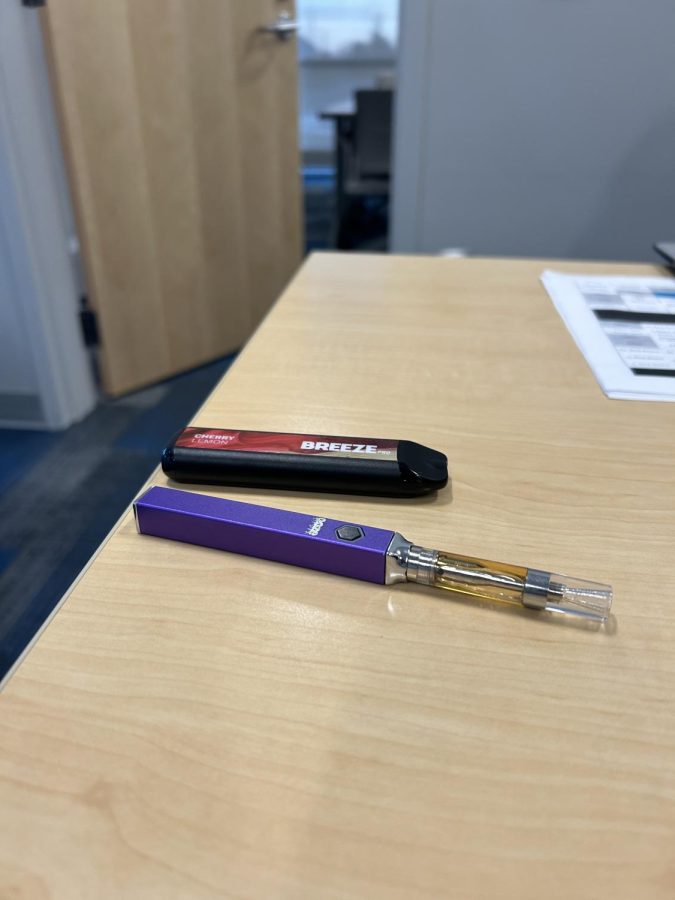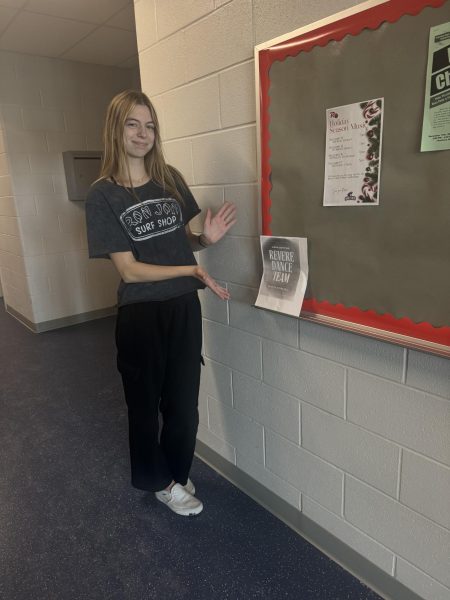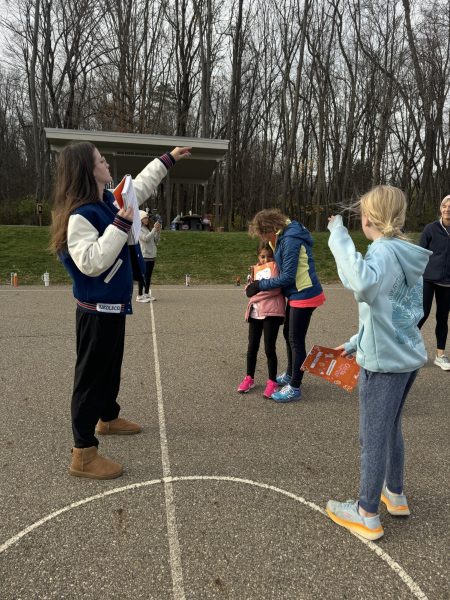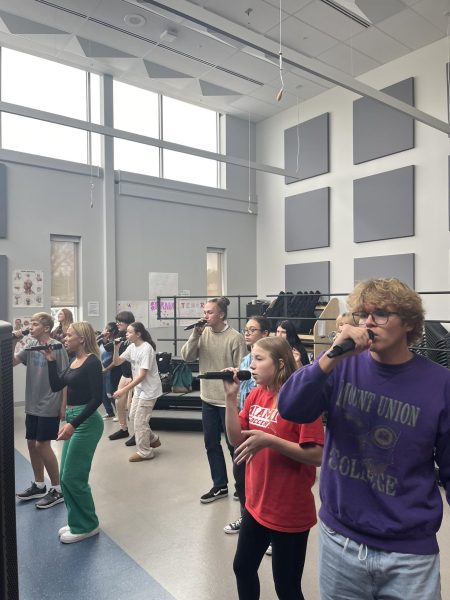District looks for solution to e-cigarette problem
Mr. Faris shows the e-cigarettes he has confiscated.
When a high school student enters a bathroom or locker room, they are often bombarded with sweet scents of fruit and cotton candy. Although an outsider may think nothing of the syrupy scents, many students quickly identify the synthetic smell as that of an e-cigarette. In fact, according to the 2022 National Youth Tobacco Survey (NYTS), more than three million high school and middle school students report using e-cigarettes, commonly called vapes. With nearly a fifth of American high schoolers using the devices, many students, no matter their intentions, often come into contact with the product.
This nationwide epidemic is not absent from Revere. Throughout the last decade, vaping incidents have continued to rise within the building, leading the administrative team to install special vape detectors in all bathrooms in 2019. Although the detectors continue to contact administrators upon sensing a change in air quality, often the notification comes too late for administrators to find the student vaping.
Without an effective system for enforcing Revere’s “no vaping” policy, some students flock to the bathrooms to use their devices. This has led to high traffic within restrooms, especially during passing periods, preventing other students from using the bathrooms for their intended purpose.
Assistant Principal Doug Faris has been working at RHS for the past six years and has worked in education for over twenty years. In that time, he has watched the popularity of vaping increase drastically.
As outlined in the student handbook, Revere has a “no vaping” policy, but instead of the former punishment of suspension, administrators have instituted a more proactive approach, educating caught students about the dangers of vaping. Faris outlined the pathway of consequences a student takes if caught.
“In the first offense, we always want to make that parent contact and get parents involved. If you’re caught vaping, it does come with a suspension, but what we do to try to build the relationship with the kid and the parent is we say you’re going to be suspended three days, but if you agree to work with Mrs. Simonelli in our vaping awareness program, we’ll drop a day off. It’s kind of an incentive,” Faris said.
Instead of a three-day suspension, students agreeing to partake in the program will only receive a two-day suspension. If a student is caught with a vape again, the punishment for a second offense is a five-day suspension and a third offense would result in a suspension for up to ten days.
This new approach is not unique to Revere, at-risk student coordinator Bonnie Simonelli explained. Simonelli believes for many, a suspension does not solve the issue at hand and negatively affects the student’s relationship with school. No matter the situation, being absent from the classroom creates additional work for students and teachers. To both enforce punishment and help the student learn the dangers of vaping, Revere uses a combined approach.
“A lot of schools are doing that as an alternative to suspension. A suspension is just sitting all day, either in or out of school. You’re not getting educated. A lot of schools are doing an alternative to suspension with education, but Revere is the first school I’ve worked in that has done it,” Simonelli said.
The vaping awareness program that Simonelli provides is an all-around education about the dangers of vaping, cumulating with an opportunity for students to enter a nicotine rehab program.
“It is a four-day session that I was trained in by American Lung Association, and it deals with addiction to nicotine, other things to do besides nicotine, the marketing of nicotine to young people and a comprehensive fourth session that goes overall of that. If they want to quit, I lead them into a cessation. There are nicotine cessation programs out there that I help them find and get involved with,” Simonelli said.
According to Revere’s official vaping policy, if a vape detector goes off, all students in the vicinity will receive the same consequences. Simonelli explained why this policy was enacted.
“I’ve had a number of students that have told me that they were only in there [and gotten caught]. They weren’t vaping; the vape wasn’t even theirs, and they all have the same consequence because they were in there. You can’t really find out who was the one vaping at that moment,” she said.
Occasionally, there are exceptions to the policy, Simonelli explained.
“If there is a kid in the stall who is not involved with that, [they’re not in trouble], but if there are three kids standing around with a vape, all three of them are busted at the same time, even if one is not holding a vape,” she said.
Although Simonelli works full-time at Revere, she also offers the same vaping awareness programs in other local districts. She explained that this common policy of disciplining all students in the area serves as a good prevention, even for students not involved.
“The same vaping informative lessons I do here, I do it online for another school [district], Parma City Schools. I’ve had a lot of kids tell me, ‘I was just there in the wrong place with the wrong people,’ but same as Revere, you get the same punishment, and that’s a good prevention,” Simonelli said.
Simonelli further explained the benefits that come out of her vaping awareness program for all students.
“Maybe you don’t vape, but it’s good to hear this information before you pick up a vape. Once you’re hanging out with it, you might be in there four, five, six times with the same people, and one time you say, ‘let me try it, what’s the big deal?’ But now, [after participating in the program], you didn’t try it. Now you have an education,” Simonelli said.
Within her session, Simonelli gets to know the student and figure out their circumstances. For each student, their reasons for turning to vapes are different, but the strong power of addiction remains constant throughout each story.
“I ask people, when did you know you were addicted? [A student] said, ‘when I bought my own. Before, I would just take a hit from somebody else, but then I really needed to have my own with me all the time because I needed to hit it when I needed to hit it,’” Simonelli said.
With vaping incidents on the rise in Revere and the rest of the nation, Simonelli worries about the future.

“Lately, I have students [attending vaping awareness sessions] almost three days a week. Just as soon as one session ends, I’m starting another one. We keep getting more, which tells me something really bad. It tells me that it’s not going away; it never will,” Simonelli said.
As traditional cigarette sales continue to decrease, tobacco consumers and producers have turned to these new electronic cigarettes as an alternative. Originally, they were marketed as a healthier, safer version of smoking, but research has since disproved that claim. Simonelli explained how and why vaping was introduced to the market.
“I’d say [for] about fifteen years now, we’ve had a history of vaping. What happened was when the big tobacco companies saw their sales going down, [they introduced vaping]. For years, they saw their sales going up, and then all of a sudden, they plateaued; they weren’t going up, and companies started to panic,” Simonelli said.
False marketing and extensive advertising to young people have led to large success for tobacco companies. With slim, modern-looking devices and fun, youthful flavors, tobacco companies have captured a young audience.
“They created the better mouse trap. They made fruity flavors targeted toward young people. There’s no offensive smell. They made it so easy. It started so sneaky with the pods and the puffs, but now they make it so small that you can get away with it in the back of a classroom, the back of a bus or in a restaurant,” Simonelli said.
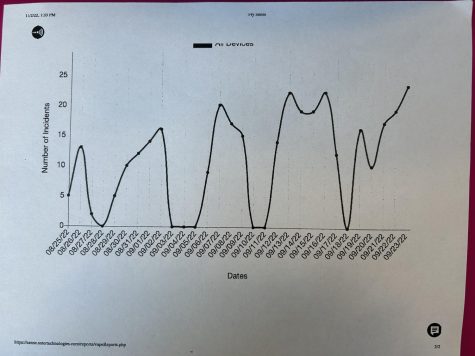
According to the NYTS study, overwhelmingly, users flock to youthful flavors, with fruit flavors being the most popular, followed by candy, desserts and other sweets.
“They did that really on purpose. Once you have the addiction, you need to use it in any way you can. When I talk to a kid who has gotten busted and say ‘you can’t even go a full day of school without vaping, making sure you have one on you, you have an addiction. It has gotten you.’ Eventually, even if you can leave it at home, the more you use it, the addiction grows. You might think you’re beating it by leaving it at home, but soon you’re going to start bringing it to school,” Simonelli said.
Simonelli compares vaping to COVID. Both attack the lungs and have much we don’t know about it yet, but only one is a choice people make.
“I almost call it the COVID of smoking because there’s so much we don’t know down the line. We just don’t know the effects it’s going to have on the lungs and the body. [Of the] people who got COVID, [those who] did very poorly were the vapers and the smokers. COVID attacks the lungs and so does vaping,” Simonelli said.
As mentioned, Revere High School installed vape detectors in all bathrooms in the 2019-2020 school year and moved them to the new high school upon construction completion. Faris explained the reasoning behind installing the detectors and the impact they have today.
“To help with vaping, we use FlySense, so these are the vaping detectors. You can see the vape detector might go off twenty times a day. That’s not to say there are twenty kids vaping. The vape detector picks up changes in air quality inside the bathroom, so if you go out and take out a body spray and spray it, it’s going to go off. It’s hard for us to exactly say, but it does help,” Faris said.
RHS Principal Dr. Andy Peltz is grateful for the vape detectors but understands their limits.
“We have some vape detectors and while it’s a deterrent, it’s sometimes hard to still catch people in the act, especially in a crowded bathroom… Just trying to catch them is sometimes hard. By the time I get down there, they’re gone,” Peltz says.
The FlySense detectors work by monitoring the air quality in real time and claim to detect THC, tobacco, and other vaping products. Faris explained how they work.
“There is a baseline reading with nobody in the bathroom, and then when it picks up that change in air quality, it goes off. Then it would come straight to [Principal Dr. Andy] Peltz’s phone, [Officer Scott] Dressler’s phone, and my phone, so we get a text,” Faris said.
Faris is also aware of the limits of the detectors, sharing how it can be difficult to make it to one end of the school from the other in time to catch someone in the act.
“It does help. Sometimes it’s frustrating because you’ll be down in the cafeteria and it’ll go off in the A-wing and you’re like, ‘by the time I walk down there, they’re going to be gone.’ It’s tricky, but it does help,” Faris said.
This isn’t always the case, however. If an administrator is in the area, they can enter the bathroom immediately upon receiving the notification.
“I’ve gotten two so far today, and I actually happened to be standing right by this bathroom and with a few seconds, I was able to go in the bathroom,” Faris said.
The notification that a vape detector has sensed something goes to three people: Principal Andy Peltz, Assistant Principal Doug Faris, and Student Resource Officer Scott Dressler, all three being male. This greatly limits their ability to enforce the rules within the female restrooms.
“It’s hard that we don’t have a female administrator, so the female bathrooms present a challenge,” Faris said.
Peltz elaborated, sharing that they will ask a female staff member to intervene.
“Some teachers, we’ll ask if they’re in the vicinity. A lot of times I’ve had to pull them from class. The secretaries will help out. Nurses have helped out, but it is difficult. Mr. Faris and I will see it went off in a female bathroom, but by the time it goes off, and we try to get someone down there, it’s just not happening. Officer Dressler has the same sort of limitations. It’s a problem,” Peltz said.
These issues are not just present at the high school but also the middle school, which also has vape detectors in the restrooms.
Simonelli has worked at Revere High School, Revere Middle School and Bath Elementary School for eight years, teaching the dangerous of alcohol and drugs. At the elementary school, Simonelli instructs using the Too Good for Drugs curriculum, a prevention education program for K-12. Simonelli shares how her experience with the program has changed.
“I do Too Good for Drugs at Bath; I just finished that and actually for the first time this year, the tobacco lesson, I turned to all about vaping. I didn’t even say smoking because kids don’t even think about smoking anymore. It’s all vaping. It was probably the best lesson I ever taught and it was a prevention lesson,” Simonelli said.
When designing her vaping lesson, Simonelli spoke with students in the PANDA club at RMS, a group dedicated to stopping drug and alcohol abuse. With vaping prominent at the middle school, these students were adament that even elementary aged students need to hear the dangers of vaping.
“I talked with my PANDA kids and asked them how real I should get with the kids. They told me get real about vaping, especially with the fifth graders. They are about to go to the middle school. They’ve seen it. They may have even been tempted to try it. When they get here, it will be all in their face,” Simonelli said.
Simonelli looks to the future, hoping students will make the change. She warns that anyone could fall into the addictive trap.
“There is no one type of student that vapes; it’s across the kids that play sports, the kids in band, the kids that aren’t. There is no one kid who has gotten into it. There isn’t a stereotypical kid who vapes; it’s everyone,” Simonelli said
If a student would like to discuss vaping or receive help, Simonelli encourages them to speak with her. She is available by email at [email protected] or by phone at (330) 523-3415. All conversations will be confidential.

